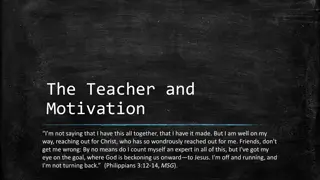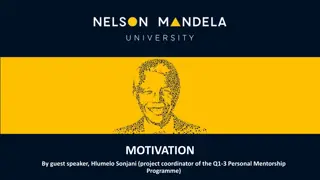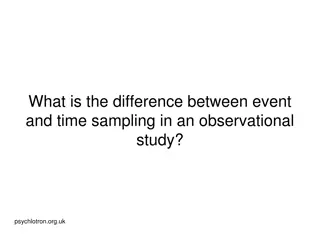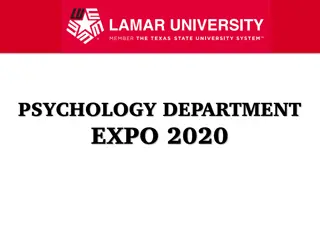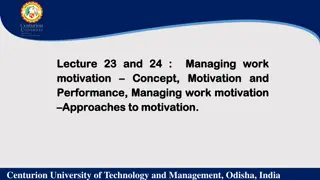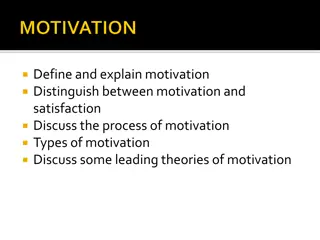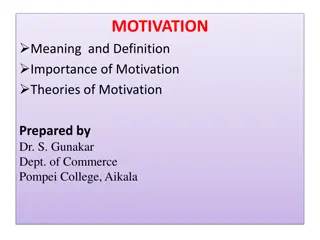Understanding Human Motivation: Social Psychology Insights
Motivation plays a crucial role in shaping human behavior, driving individuals to set and achieve goals. Internal motivation, driven by personal desires, is more effective than external incentives. Maslow's Hierarchy of Needs highlights the different levels of motivation, from basic survival needs to self-actualization. Reward and punishment also influence behavior in the workplace, with timely rewards being more effective than delayed punishments. Recognizing demotivation signs is essential to address lack of motivation in individuals. Social psychology provides valuable insights into understanding human behavior and motivation.
Download Presentation

Please find below an Image/Link to download the presentation.
The content on the website is provided AS IS for your information and personal use only. It may not be sold, licensed, or shared on other websites without obtaining consent from the author. Download presentation by click this link. If you encounter any issues during the download, it is possible that the publisher has removed the file from their server.
E N D
Presentation Transcript
MOTIVATION Motivated behavior is goal directed, purposeful behavior. No human behavior occurs without some kind of motivation behind it. In aircraft maintenance, technicians are trained to carry out the tasks within their expertise. However, it is largely their motivation which determines what they actually do in any given situation. Thus, motivation reflects the difference between what someone can do and what they will do . Motivation can be thought of as a basic human drive that arouses, directs, and sustains all human behavior. Generally we say a person is motivated if they take action to achieve something Internal motivation (doing things because you want to rather than because someone else has told you to) is far more effective than external sticks and carrots. Punishing or rewarding inappropriately) people who are internally motivated can be counter productive.
REWARD AND PUNISHMENT: EFFECTS ON BEHAVIOR The below figure summarizes what psychologists know about the effects of reward and punishment in the workplace. Rewards are the most powerful means of changing behavior, but they are only effective if delivered close in time and place to the behavior that is desired. Delayed punishments have negative effects: they don t lead to improved behavior and they make people resentful The cells labeled doubtful effects mean that, in each case, there are opposing forces at work. Hence, the results are uncertain
MASLOWS HIERARCHY OF NEEDS One well known theory which attempts to describe human motivation is Maslow s hierarchy of needs. Maslow considered that humans are driven by two different sets of motivational forces: those that ensure survival by satisfying basic physical and psychological needs; those that help us to realize our full potential in life known as self actualization needs (fulfilling ambitions, etc.). The following figure shows the hypothetical hierarchical nature of the needs we are motivated to satisfy. The theory is that the needs which are lower down the pyramid are more primitive and must be satisfied before we can be motivated by the higher needs. The higher up the pyramid one goes, the more difficult it becomes to achieve the need. High level needs are often long term goals that have to be accomplished in a series of steps
DEMOTIVATION Highly motivated people tend to show the following characteristics: -high performance and results being consistently achieved -the energy, enthusiasm and determination to succeed -unstinting cooperation in overcoming problems -willingness to accept responsibility -willingness to accommodate change People who are demotivated lack motivation, either internally or through a failure of their management to motivate them. Demotivated people tend to demonstrate the following characteristics: -apathy and indifference to the job, including reduced regard for safety while working -a poor record of time keeping and high absenteeism -an exaggeration of the effects/difficulties encountered in problems, disputes and grievances -a lack of cooperation in dealing with problems or difficulties unjustified resistance to change
PEER PRESSURE In the working environment of aircraft maintenance, there are many pressures brought to bear on the individual technician, including the possibility that he/she will receive personal pressures from those that work with them. This is known as peer pressure. Peer pressure is the actual or perceived pressure which an individual may feel, to better conform to what they perceive that their peers or colleagues expect Conformity is the tendency to allow one s opinions, attitudes, actions and even perceptions to be affected by prevailing opinions, attitudes, actions and perceptions Peer pressure is the pressure we feel to do what our group or peers expect of us. Peer pressure is closely linked to organizational norms and culture. As with organizational culture, peer pressure or conformity can work either for, or against safety
THE INFLUENCE OF ORGANIZATIONAL CULTURE ON SAFETY The failure of maintenance and inspection personnel to adhere to proper maintenance and quality assurance procedures for the aircraft s horizontal stabilizer de-ice boots. This led to the sudden inflight loss of the partially secured left horizontal stabilizer leading edge, and the immediate severe nose down pitch over and breakup of the aircraft. A contributing cause of the accident was the failure of management to ensure compliance with the approved maintenance procedures. In addition, the failure of FAA surveillance to detect and verify compliance with approved procedures was cited
TEAM WORK Teams require interdependence; members working together in ways to achieve one or more common goals. Successful teamwork is achieved when the output of the team is greater than what the output would be by the combined efforts of the individual members in isolation. This is a process known as synergy. Synergy occurs when each individual team member is empowered and encouraged to contribute in the most effective way to the overall task of the team. Interaction between team members creates a positive environment, increasing efficiency and productivity.
TEAMWORK This interaction is unlikely to occur unless all members of the team fully understand their role within the group, and how this role might vary depending on circumstances. Consequently, good communications within the group, a high degree of situational awareness, and a comprehensive understanding of the decision making process by all members are prerequisites for creating synergy. Sound teamwork in aviation maintenance is also a vital error management tool. There are many examples where maintenance team failures have been found to be major factors in aviation accidents
CHARACTERISTICS OF TEAMS Good teams have certain characteristics. Typically, individual team members have high levels of task proficiency and good team skills. So what are the characteristics of teams with good synergy? These teams: Share and understand a common goal Have effective and balanced leadership Have effective followership (or team) skills Have a shared mental model Practice clear and effective communication Have clear delegation/role definition Have clear operating procedures Allocate workload appropriately Have an appropriate authority gradient Resolve conflict effectively
CONDITIONS FOR EFFECTIVE TEAMWORK A SHARED AND UNDERSTOOD GOAL This is closely linked with providing a clear pre task briefing. It is often assumed that everyone in the team knows what the goal is. However, this is not always the case. For a team to be effective, all team members need to know what the specific goal is, as well as what they need to do to achieve it. When the team has a shared and understood goal, all members of the team are pulling in the same direction to achieve the stated goal, rather than working in isolation. EFFECTIVE LEADERSHIP AND FOLLOWERSHIP Good balanced leadership and followership skills are critical for effective team performance. The team leader needs to manage the workload, keep the team motivated, provide appropriate direction when required, and coordinate activities aimed at achieving the team goal. The follower is expected to act professionally, work towards the team goal and raise issues if they are unsure or disagree
A SHARED MENTAL MODEL For a team to be effective, each member should be aware of the expected outcomes of their work. Supervisors therefore have to communicate what is required, how they expect it to be achieved, and allocate appropriate tasks and responsibilities. The shift or task supervisor should communicate before the team begins the task. It may then require frequent briefing during the task, so the whole team remains aware of, and is focused on what needs to be achieved. Regular briefing and informal discussion with team members during the task should ensure that all team members share the same mental model. Such briefings should be carried out at the following times: At the beginning of every shift When the work priorities change When another task is issued Whenever important information needs to be communicated
Effective communication is a complex process. Some have simplistically summarized the process in these four steps: -Someone transmits information -Someone else receives that information -That receiver understands the information, and finally... -Confirms to the transmitter that they have received and understood the information
CLEAR DELEGATION & ROLE DEFINITION There must be a clear outline of who is responsible for what. Clear delegation and role definition helps to minimize duplicated effort and ensures that each team member knows what they have to do and who is responsible for what. Delegating responsibilities appropriately within the team, and defining individual team members roles, ensures activities are coordinated and no one team member is overloaded, thus allowing their ability to assist other team members when necessary. Delegating responsibilities and defining roles also ensure that team members have the capability to monitor each other s performance and provide support as required.
APPROPRIATE ALLOCATION OF WORKLOAD We tend to be most reliable under moderate levels of workload that do not change suddenly and unpredictably. When the workload becomes excessive, the likelihood of human error increases. The term workload can be summarized as the task demands placed upon an individual, and the corresponding ability of that individual to cope with those demands. An individual s ability to cope with demands will be affected by their inherent capabilities, training, skill level, tiredness, and a multitude of other factors. This has several implications: -Different people will experience different workloads for the same task. Remember how difficult it was when you were learning to drive? Changing gears required massive concentration and effort, while experienced drivers can change gear almost without thinking. -Workload levels will vary as time passes. High workload and inappropriate/unrealistic time frames in which to achieve tasks can have an adverse effect on team performance. Maintenance teams that experience a consistently high workload, or are confronted with conflicting demands to complete tasks within an unrealistic time frame often use shortcuts and workarounds. Workload, therefore, must be appropriately balanced within the team
LEADERSHIP CHARACTERISTICS OF A GOOD LEADER A leader in a given situation is a person whose ideas and actions influence the thought and the behavior of others. There are potentially two types of leader in aircraft maintenance: 1) the person officially assigned the team leader role (possibly called the Supervisor) 2) an individual within a group that the rest of the group tends to follow or defer to (possibly due to a dominant personality, etc.). Ideally of course, the official team leader should also be the person the rest of the group defers to
LEADERSHIP WHAT IS LEADERSHIP Motivating the Team: The leader organizes the team by ensuring that the goals or targets of the work which need to be achieved are clearly communicated and manageable. For instance, the team leader would describe the work required on an aircraft within a shift. The leader must be honest and open, highlighting any potential problems and where appropriate encourage team solutions. Reinforcing Good Attitudes and Behavior: When team members work well (i.e. safely and efficiently), this must be recognized by the team leader and reinforced. This might be by offering a word of thanks for hard work, or making a favorable report to senior management on an individual. A good leader will also make sure that bad habits are eliminated and inappropriate actions are constructively criticized. Demonstrating by Example: One of the most important leadership qualities is setting an example; doing what they say. They must demonstrate a personal understanding of the activities and goals of the team so that the team members respect their authority. It is particularly important that the team leader establishes a good safety culture within a team through attitude and actions.
LEADERSHIP WHAT IS LEADERSHIP Maintaining the Group: Individuals do not always work together as good teams. It is part of the leader s role to be sensitive to the structure of the team and the relationships within it. They must engender a team spirit where the team members support each other and feel responsible for the work of the team. They must also recognize and resolve disputes within the team and encourage cooperation amongst its members. Fulfilling a Management Role: The team leader must not be afraid to lead (and diplomatically making it clear that there cannot be more than one leader in a team). The team leader is the link between higher levels of management within the organization and the team members who actually work on the aircraft. The leader is responsible for coordinating the activities of the team on a day to day basis, which includes allocation of tasks and delegation of duties. There can be a tendency for team members to transfer some of their own responsibilities to the team leader. This must be resisted.
LEADERSHIP WHAT LEADERSHIP IS NOT Leadership is not power. The thug who sticks a gun in your back has power, but not leadership. Leadership is not status. Some may have status or position, yet do not have a shred of leadership . Position is assigned from above ... leadership is conferred from below. Leadership is not authority. Bosses will naturally have subordinates, but if bosses do not lead, they will not have followers. Leadership is not management. Managing is a planned activity: leadership is more spontaneous. Managers do things right. Leaders do the right things
LEADERSHIP Management is about making sure people CAN work safely; that is, provide the right tools and equipment, have good policies and procedures, hold safety meetings and training, and so on. Leadership, on the other hand, is about helping to ensure that people WILL work safely: providing consistent feedback to people when they are doing the right kinds of things around safety, make safety meetings engaging and relevant, model safe behaviors in all, make the connection and balance between production, quality, and safety and celebrate successes.



